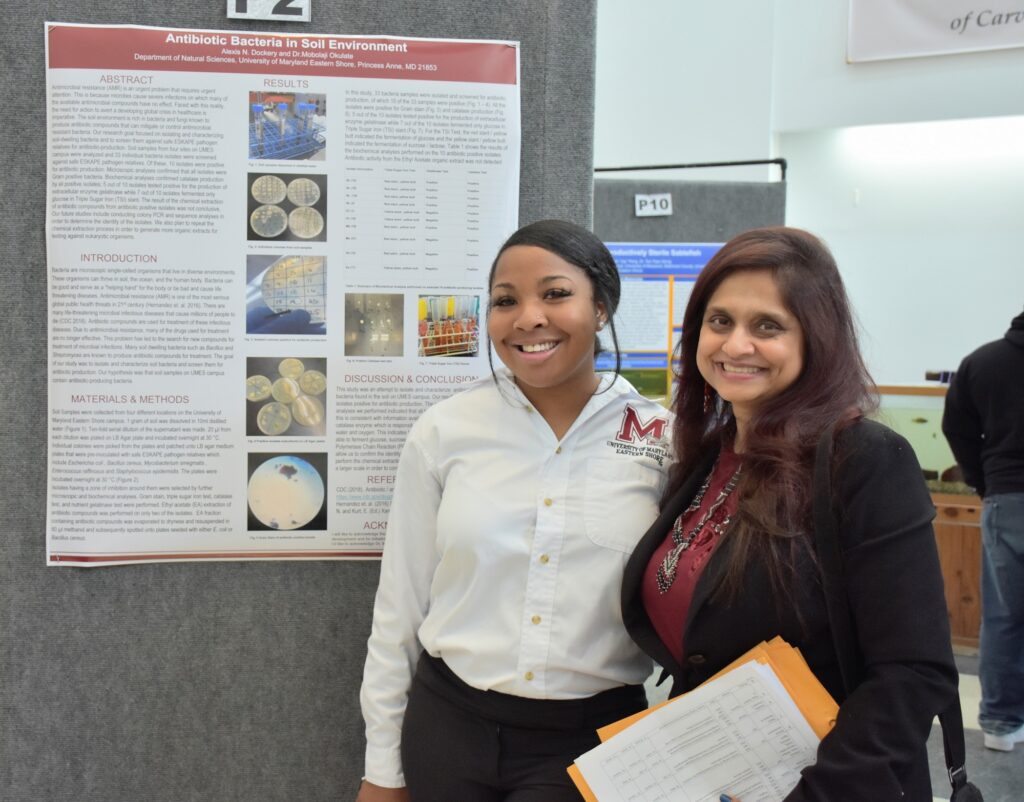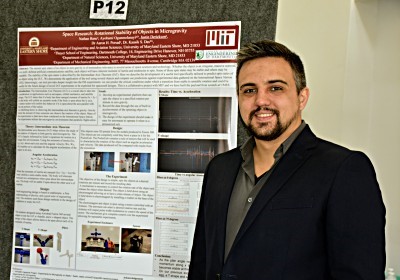
Undergraduate students registered in the biology, environmental science, chemistry and physics 499 research courses showcased the work they researched under their faculty advisors. The end-of-the-semester Undergraduate Research Poster Symposium took place December 5 in Carver Hall. Fourteen students presented, while more than 30 students, who either co-authored the posters or did peer evaluations, attended.
Yasmin Roye took first place with her research poster titled, “Investigation of Neutrophil Sequestration Using a Lung Capillary Constriction Device.” Her advisor was Dr. Jennifer Bobenko.
“My research from summer 2019 at Brown University looked at the causes of neutrophil accumulation in the lung,” Roye said. “This directly leads to lung tissue injury and occurs in patients with extended stays in the hospital (i.e. recovering from a heart attack), leading to more susceptibility to sepsis which already has a mortality rate of almost 40 percent.” Roye and Bobenko used in vitro microfluidic channels modelled after the lung capillary bed (where neutrophils circulate) to study the mechanism by which the cells get stuck and accumulate.
“Preliminarily, we found that the neutrophil’s cytoskeleton (via vinculin proteins) is responsible for the stiffening response that causes the cells to accumulate,” Roye said. “Current research includes using an in vivo mouse model to confirm the results we obtained in vitro.”
Second place went to Justin Derickson with, “Space Research: Rotational Stability of Objects in Microgravity,” mentored by Dr. Kausiksankar Das, assistant professor.
Derickson along with three other students at UMES built a payload to conduct experiments under zero-gravity conditions. “The team built the payload from scratch at UMES and it flew a suborbital flight from Ottawa, Canada in 2019 to study solid body rotation dynamics in zero gravity,” Das said. “Justin played a pivotal role in this collaborative project with researchers from MIT and the National Research Council of Canada.” He is also involved in other research projects on nano sensors, solar steam generation and plasma research, Das said.
Das’ teaching and research are supported by the National Science Foundation (HBCU-UP Award #1719425), the Department of Education (MSEIP Award #P120A70068) with a MSEIP CCEM grant. To learn more about the research group’s activities visit: https://sites.google.com/view/kausik-das/research.
Othman Suleiman received third place for his research titled, “Breaking the Boundaries of Microfluidic Mixing with Sharpie Dots,” also with faculty mentor Das and fellow students Habilou Ouro-Koua and Ayobami Ogunmolsuyi.
The research team hypothesized that “changing the boundary conditions and the geometry of microfluidic channels using fractal geometries will considerably enhance mixing of two reagents while increasing the efficiency of the system even in low Reynolds number flow.”
According to Suleiman, his role in the project was building the channels and testing it side-by-side with Habilou to observe if there was a new result. He spent time designing the fractals with different sizes and lengths in 2D and 3D and simulated the experiment hypothetically with computer software before it was tested in the real-world, “which saved us time and effort.”
Suleiman and his team worked with Das over a two-year period. Das was “the one who provided all the necessary resources to ensure our success,” Suleiman said. They found that “keeping the Reynolds number constant around 10, the data obtained clearly show that fractal geometries and boundary conditions variation have an impact in increasing mixing in microchannels. With periodic hydrophobicity, we are able to improve mixing in the microchannels and the missing rate increases with increase in the number of slip dots.”
“All in all, this research project is one of my favorites since I was able to apply my skills designing and simulating to get the best outcome with less time and effort,” Suleiman said.
“Dr. Niemi, our vice provost, was very impressed with the quality of the research that our students have been doing along with their super advisors,” said Dr. Madhumi Mitra, professor, Department of Natural Sciences and coordinator of the Fall 2019 poster session. “All of the posters received excellent scores and our department has the best faculty. It is truly an honor to belong here.”
Judges for the symposium were: Dr. Tracy Bell, Dr. Jennifer Bobenko, Dr. Maurice Crawford, Dr. Kausiksankar Das, Dr. Ligia DaSilva, Dr. Ali Ishaque, Dr. Behnam Khatabi, Dr. Eric May, Dr. Mobolaji Okulate, Dr. Joseph Pitula,; Amelia Potter, Dr. Margaret Sexton, Dr. Deborah Sauder, Dr. Maryam Taabodi, Dr. Victoria Volkis and Dr. Simon Zebelo.
Winners were based on the compiled scores from the judges, said Mitra. There was a standardized evaluation rubric covering all the aspects of posters including: abstract, introduction, materials and methods, results and discussion, conclusions, literature citation, appearance of posters, in addition to how well they responded to questions, English usage and grammar.




